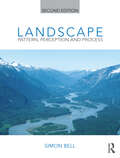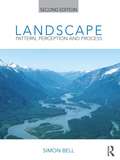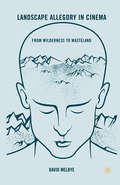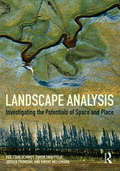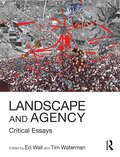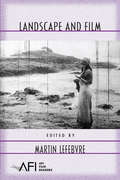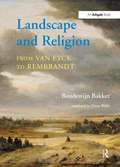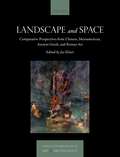- Table View
- List View
Lands of Likeness: For a Poetics of Contemplation
by Kevin HartAn original and profound exploration of contemplation from philosopher, theologian, and poet Kevin Hart. In Lands of Likeness, Kevin Hart develops a new hermeneutics of contemplation through a meditation on Christian thought and secular philosophy. Drawing on Kant, Schopenhauer, Coleridge, and Husserl, Hart first charts the emergence of contemplation in and beyond the Romantic era. Next, Hart shows this hermeneutic at work in poetry by Gerard Manley Hopkins, Marianne Moore, Wallace Stevens, and others. Delivered in its original form as the prestigious Gifford Lectures, Lands of Likeness is a revelatory meditation on contemplation for the modern world.
Landscape: Pattern, Perception and Process
by Simon BellLandscapes develop and evolve through an interacting series of processes – climatic, geological, ecological and cultural – over varying periods of time. These processes shape the structure and character of the landscapes which we experience. Over time, distinctive patterns emerge – ranging in scale from the distribution of small plants to the sculptured sides of a huge canyon. Our perception of these patterns goes beyond just their visual appreciation – beautiful though they may be – into a richer understanding of how we experience our environment. By understanding this complex pattern–process interaction we can obtain a deeper awareness of landscape and our place in it – as inhabitants and as shapers. The book explores the nature of patterns and ways of classifying them before studying the nature of perception (primarily visual but including other senses), then proceeds to relate this perception to aesthetics and from there to the design process. From this point the main driving processes in landscape are introduced alongside the resulting patterns, these being climatic, landform, ecosystem and cultural aspects. It is this integrative approach of looking at landscape as a kind of self-organising system, overlaid by conscious human planning activities and the unity of pattern and process, which makes this book unique. Landscape draws from a wide range of neighbouring disciplines, of which the landscape planner or designer needs to be aware, but which are often taught as distinct elements. Bell binds these fundamentals together, which enables the landscape to be ‘read’, and this reading to be used as the basis for planning and design. This second edition updates and refreshes the original material with added sections and new photos, particularly making use of the developments in satellite photography. Featuring full colour throughout, this textbook is ideal for anyone studying landscape architecture or any of the disciplines which intersect with the landscape, and which affect it.
Landscape: Pattern, Perception and Process
by Simon BellLandscapes develop and evolve through an interacting series of processes – climatic, geological, ecological and cultural – over varying periods of time. These processes shape the structure and character of the landscapes which we experience. Over time, distinctive patterns emerge – ranging in scale from the distribution of small plants to the sculptured sides of a huge canyon. Our perception of these patterns goes beyond just their visual appreciation – beautiful though they may be – into a richer understanding of how we experience our environment. By understanding this complex pattern–process interaction we can obtain a deeper awareness of landscape and our place in it – as inhabitants and as shapers. The book explores the nature of patterns and ways of classifying them before studying the nature of perception (primarily visual but including other senses), then proceeds to relate this perception to aesthetics and from there to the design process. From this point the main driving processes in landscape are introduced alongside the resulting patterns, these being climatic, landform, ecosystem and cultural aspects. It is this integrative approach of looking at landscape as a kind of self-organising system, overlaid by conscious human planning activities and the unity of pattern and process, which makes this book unique. Landscape draws from a wide range of neighbouring disciplines, of which the landscape planner or designer needs to be aware, but which are often taught as distinct elements. Bell binds these fundamentals together, which enables the landscape to be ‘read’, and this reading to be used as the basis for planning and design. This second edition updates and refreshes the original material with added sections and new photos, particularly making use of the developments in satellite photography. Featuring full colour throughout, this textbook is ideal for anyone studying landscape architecture or any of the disciplines which intersect with the landscape, and which affect it.
Landscape Allegory in Cinema: From Wilderness to Wasteland
by D. MelbyeThis study seeks to understand the form of cinematic space referred to as 'the landscape of the mind,' in which natural, outdoor settings serve as outward manifestations of characters' inner subjective states.
Landscape Analysis: Investigating the potentials of space and place
by Per Stahlschmidt Simon Swaffield Jorgen Primdahl Vibeke NellemannA key aspect of town planning, landscape planning and landscape architecture is to identify and then use the distinctive features and characteristics of space, place and landscape to achieve environmental quality. Landscape Analysis provides an introduction to the field both in theory and in practice. A wide range of methods and techniques for landscape analysis is illustrated by urban and rural examples from many countries. Analysing landscapes within a planning context requires both skill and insights. Drawing upon numerous concrete examples, together with an examination of some theoretical concepts, this book guides the reader through a wide range of different approaches and techniques of landscape analysis that may be applied at different scales, from elementary site analysis to historical and regional studies. This is an essential book for students and graduate practitioners working in landscape architecture, planning and architecture.
Landscape Analysis: Investigating the potentials of space and place
by Per Stahlschmidt Simon Swaffield Jorgen Primdahl Vibeke NellemannA key aspect of town planning, landscape planning and landscape architecture is to identify and then use the distinctive features and characteristics of space, place and landscape to achieve environmental quality. Landscape Analysis provides an introduction to the field both in theory and in practice. A wide range of methods and techniques for landscape analysis is illustrated by urban and rural examples from many countries. Analysing landscapes within a planning context requires both skill and insights. Drawing upon numerous concrete examples, together with an examination of some theoretical concepts, this book guides the reader through a wide range of different approaches and techniques of landscape analysis that may be applied at different scales, from elementary site analysis to historical and regional studies. This is an essential book for students and graduate practitioners working in landscape architecture, planning and architecture.
Landscape and Agency: Critical Essays
by Ed Wall Tim WatermanLandscape and Agency explores how landscape, as an idea, a visual medium and a design practice, is organized, appropriated and framed in the transformation of places, from the local to the global. It highlights how the development of the idea of agency in landscape theory and practice can fundamentally change our engagement with future landscapes. Including a wide range of international contributions, each illustrated chapter investigates the many ways in which the relationship between the ideas and practices of landscape, and social and subjective formations and material processes, are invested with agency. They critically examine the role of landscape in processes of contemporary urban development, environmental debate and political agendas and explore how these relations can be analysed and rethought through a dialogue between theory and practice.
Landscape and Agency: Critical Essays
by Ed Wall Tim WatermanLandscape and Agency explores how landscape, as an idea, a visual medium and a design practice, is organized, appropriated and framed in the transformation of places, from the local to the global. It highlights how the development of the idea of agency in landscape theory and practice can fundamentally change our engagement with future landscapes. Including a wide range of international contributions, each illustrated chapter investigates the many ways in which the relationship between the ideas and practices of landscape, and social and subjective formations and material processes, are invested with agency. They critically examine the role of landscape in processes of contemporary urban development, environmental debate and political agendas and explore how these relations can be analysed and rethought through a dialogue between theory and practice.
Landscape and Branding: The promotion and production of place (Routledge Research in Landscape and Environmental Design)
by Nicole PorterLandscape and branding explores the way landscape is conceptualised, conceived, represented and designed by professionals in a brand-driven age. Landscape - incorporating tangible physical space as well as intangible concepts, narratives, images, and experiences of place - is constructed by a number of creative industries. This book tests the hypothesis that place branding, a powerful marketing and management practice, increasingly blurs the distinction between the promotion of landscape and its production in design terms. Place branding involves the strategic and systematic composition of single-minded, experiential and market-friendly place identities which are consistently communicated across various media, including physical space. How does this implicate or transform notions of place, nature, landscape experience, and the qualitative value of landscape itself? How does this affect the role of landscape architecture? To answer these questions, place branding theory and practice is critically examined alongside an in depth case study of one specific landscape - the Blue Mountains (Australia). Projects undertaken between 1995 and 2015, including a branding strategy for the region, media campaigns, television, cinema, and several landscape architectural works in the public and private domain are comparatively analysed, focusing on the discourse, conventions and values informing their production, and the landscape narratives they convey.
Landscape and Branding: The promotion and production of place (Routledge Research in Landscape and Environmental Design)
by Nicole PorterLandscape and branding explores the way landscape is conceptualised, conceived, represented and designed by professionals in a brand-driven age. Landscape - incorporating tangible physical space as well as intangible concepts, narratives, images, and experiences of place - is constructed by a number of creative industries. This book tests the hypothesis that place branding, a powerful marketing and management practice, increasingly blurs the distinction between the promotion of landscape and its production in design terms. Place branding involves the strategic and systematic composition of single-minded, experiential and market-friendly place identities which are consistently communicated across various media, including physical space. How does this implicate or transform notions of place, nature, landscape experience, and the qualitative value of landscape itself? How does this affect the role of landscape architecture? To answer these questions, place branding theory and practice is critically examined alongside an in depth case study of one specific landscape - the Blue Mountains (Australia). Projects undertaken between 1995 and 2015, including a branding strategy for the region, media campaigns, television, cinema, and several landscape architectural works in the public and private domain are comparatively analysed, focusing on the discourse, conventions and values informing their production, and the landscape narratives they convey.
Landscape and Film (AFI Film Readers)
by Martin LefebvreFirst published in 2006. Routledge is an imprint of Taylor & Francis, an informa company.
Landscape and Film (AFI Film Readers)
by Martin LefebvreFirst published in 2006. Routledge is an imprint of Taylor & Francis, an informa company.
Landscape and Infrastructure: Reimagining the Pastoral Paradigm for the Twenty-First Century
by Margaret Birney VickeryLandscape and Infrastructure examines the relationship between infrastructure, nature and culture from the 17th century to the present. It looks at the ways in which infrastructure in the urban and rural landscape has been both celebrated and reviled, and provides powerful lessons for architects and landscape designers who are once more seeking to remarry nature, community, sustainability, and infrastructure. Part One of the book traces the history of infrastructural projects through paintings, architecture and landscape design, exploring how they have been variously represented through history as symbols of civic pride and progress, while at other times segregated and disparaged for pollution and poor conditions. Part Two shows how these are not merely historical considerations: from solar and wind farms, to water treatment facilities, waste to energy, and digital infrastructures, we find many of the same debates and challenges at play today. Within a broader historical and cultural context, it showcases the innovative work of contemporary designers who are finding inspiring new ways to reintegrate infrastructure projects into our landscapes and communities. By identifying historical precedents, this study sheds new light on contemporary debates and provides valuable insights into current discussions about infrastructure, landscape, and sustainability.
Landscape and Infrastructure: Reimagining the Pastoral Paradigm for the Twenty-First Century
by Margaret Birney VickeryLandscape and Infrastructure examines the relationship between infrastructure, nature and culture from the 17th century to the present. It looks at the ways in which infrastructure in the urban and rural landscape has been both celebrated and reviled, and provides powerful lessons for architects and landscape designers who are once more seeking to remarry nature, community, sustainability, and infrastructure. Part One of the book traces the history of infrastructural projects through paintings, architecture and landscape design, exploring how they have been variously represented through history as symbols of civic pride and progress, while at other times segregated and disparaged for pollution and poor conditions. Part Two shows how these are not merely historical considerations: from solar and wind farms, to water treatment facilities, waste to energy, and digital infrastructures, we find many of the same debates and challenges at play today. Within a broader historical and cultural context, it showcases the innovative work of contemporary designers who are finding inspiring new ways to reintegrate infrastructure projects into our landscapes and communities. By identifying historical precedents, this study sheds new light on contemporary debates and provides valuable insights into current discussions about infrastructure, landscape, and sustainability.
Landscape and Power, Second Edition
by W. J. T. MitchellThe first edition of this book, published in 1994, reshaped the direction of landscape studies by considering landscape not simply as an object to be seen or a text to be read, but as an instrument of cultural force, a central tool in the creation of national and social identities. This second edition adds not only a new preface, but five new essays—from Edward Said, W. J. T. Mitchell, Jonathan Bordo, Michael Taussig, and Robert Pogue Harrison-extending the scope of the book in remarkable ways.
Landscape and Religion from Van Eyck to Rembrandt
by Boudewijn Bakker translated by Diane WebbOffering a corrective to the common scholarly characterization of seventeenth-century Dutch landscape painting as modern, realistic and secularized, Boudewijn Bakker here explores the long history and purpose of landscape in Netherlandish painting. In Bakker's view, early Netherlandish as well as seventeenth-century Dutch painting can be understood only in the context of the intellectual climate of the day. Concentrating on landscape painting as the careful depiction of the visible world, Bakker's analysis takes in the thought of figures seldom consulted by traditional art historians, such as the fifteenth-century philosopher Dionysius the Carthusian, the sixteenth-century religious reformer John Calvin, the geographer Abraham Ortelius and the seventeenth-century poet Constantijn Huygens. Probing their conception of nature as 'the first Book of God' and art as its representation, Bakker identifies a world view that has its roots in the traditional Christian perceptions of God and creation. Landscape and Religion from Van Eyck to Rembrandt imposes a new layer of interpretation on the richly varied landscapes of the great masters. In so doing it adds a new dimension to the insights offered by modern art-historical research. Further, Bakker's explorations of early modern art and literature provide essential background for any student of European intellectual history.
Landscape and Religion from Van Eyck to Rembrandt
by Boudewijn Bakker translated by Diane WebbOffering a corrective to the common scholarly characterization of seventeenth-century Dutch landscape painting as modern, realistic and secularized, Boudewijn Bakker here explores the long history and purpose of landscape in Netherlandish painting. In Bakker's view, early Netherlandish as well as seventeenth-century Dutch painting can be understood only in the context of the intellectual climate of the day. Concentrating on landscape painting as the careful depiction of the visible world, Bakker's analysis takes in the thought of figures seldom consulted by traditional art historians, such as the fifteenth-century philosopher Dionysius the Carthusian, the sixteenth-century religious reformer John Calvin, the geographer Abraham Ortelius and the seventeenth-century poet Constantijn Huygens. Probing their conception of nature as 'the first Book of God' and art as its representation, Bakker identifies a world view that has its roots in the traditional Christian perceptions of God and creation. Landscape and Religion from Van Eyck to Rembrandt imposes a new layer of interpretation on the richly varied landscapes of the great masters. In so doing it adds a new dimension to the insights offered by modern art-historical research. Further, Bakker's explorations of early modern art and literature provide essential background for any student of European intellectual history.
Landscape and Space: Comparative Perspectives from Chinese, Mesoamerican, Ancient Greek, and Roman Art (Visual Conversations in Art and Archaeology Series)
by Jaś ElsnerLandscape has been a key theme in world archaeology and trans-cultural art history over the last half century, particularly in the study of painting in art history and in all questions of human intervention and the placement of monuments in the natural world within archaeology. However, the representation of landscape has been rather less addressed in the scholarship of the archaeologically-accessed visual cultures of the ancient world. The kinds of reliefs, objects, and paintings discussed here have a significant purchase on matters concerned with landscape and space in the visual sphere, but were discovered within archaeological contexts and by means of excavation. Through case studies focused on the invention of wilderness imagery in ancient China, the relation of monuments to landscape in ancient Greece, the place of landscape painting in Mesoamerican Maya art, and the construction of sacred landscape across Eurasia between Stonehenge and the Silk Road via Pompeii, this book emphasises the importance of thinking about models of landscape in ancient art, as well as the value of comparative approaches in underlining core aspects of the topic. Notably, it explores questions of space, both actual and conceptual, including how space is configured through form and representation.
Landscape and Space: Comparative Perspectives from Chinese, Mesoamerican, Ancient Greek, and Roman Art (Visual Conversations in Art and Archaeology Series)
Landscape has been a key theme in world archaeology and trans-cultural art history over the last half century, particularly in the study of painting in art history and in all questions of human intervention and the placement of monuments in the natural world within archaeology. However, the representation of landscape has been rather less addressed in the scholarship of the archaeologically-accessed visual cultures of the ancient world. The kinds of reliefs, objects, and paintings discussed here have a significant purchase on matters concerned with landscape and space in the visual sphere, but were discovered within archaeological contexts and by means of excavation. Through case studies focused on the invention of wilderness imagery in ancient China, the relation of monuments to landscape in ancient Greece, the place of landscape painting in Mesoamerican Maya art, and the construction of sacred landscape across Eurasia between Stonehenge and the Silk Road via Pompeii, this book emphasises the importance of thinking about models of landscape in ancient art, as well as the value of comparative approaches in underlining core aspects of the topic. Notably, it explores questions of space, both actual and conceptual, including how space is configured through form and representation.
Landscape and Sustainability
by John F Benson Maggie RoeThis unique book addresses the issue of sustainability from the point of view of landscape architecture, dealing with professional practices of planners, designers and landscape managers. This second edition contains updated and new material reflecting developments during the last five years and comprehensively addresses the relationship between landscape architecture and sustainability. Much in the text is underpinned by landscape ecology, in contrast to the idea of landscape as only appealing to the eye or aspiring cerebrally to be fine art. Landscape and Sustainability establishes that the sustainability agenda needs a new mindset among professionals: the driving question must always be ‘is it sustainable?’ Developing theory into practice, from the global to the local scale and from issues of policy and planning through to detailed design and implementation and on to long-term maintenance and management, the contributors raise and re-examine a complex array of research, policy and professional issues and agendas to contribute to the necessary ongoing debate about the future of both landscape and sustainability.
Landscape and Sustainability
by John F. Benson Maggie H. RoeThis unique book is about landscape, sustainability and the practices of the professions which plan, design and manage landscapes at many scales and in many locations; urban, suburban and rural. Despite the ubiquity of 'sustainability' as a concept, this is the first book to address the relationship between landscape architecture and sustainability in a comprehensive way.Much in the book is underpinned by landscape ecology, in contrast to the idea of landscape as only appealing to the eye or aspiring cerebrally to be fine art. As this book argues, landscape is and must be much more than this; landscape architecture is about making places which are biologically wholesome, socially just and spiritually rewarding.
Landscape and Sustainability
by John F. Benson Maggie H. RoeThis unique book is about landscape, sustainability and the practices of the professions which plan, design and manage landscapes at many scales and in many locations; urban, suburban and rural. Despite the ubiquity of 'sustainability' as a concept, this is the first book to address the relationship between landscape architecture and sustainability in a comprehensive way.Much in the book is underpinned by landscape ecology, in contrast to the idea of landscape as only appealing to the eye or aspiring cerebrally to be fine art. As this book argues, landscape is and must be much more than this; landscape architecture is about making places which are biologically wholesome, socially just and spiritually rewarding.
Landscape and Sustainability
by John Benson Maggie RoeThis unique book addresses the issue of sustainability from the point of view of landscape architecture, dealing with professional practices of planners, designers and landscape managers. This second edition contains updated and new material reflecting developments during the last five years and comprehensively addresses the relationship between landscape architecture and sustainability. Much in the text is underpinned by landscape ecology, in contrast to the idea of landscape as only appealing to the eye or aspiring cerebrally to be fine art. Landscape and Sustainability establishes that the sustainability agenda needs a new mindset among professionals: the driving question must always be ‘is it sustainable?’ Developing theory into practice, from the global to the local scale and from issues of policy and planning through to detailed design and implementation and on to long-term maintenance and management, the contributors raise and re-examine a complex array of research, policy and professional issues and agendas to contribute to the necessary ongoing debate about the future of both landscape and sustainability.
Landscape and Sustainable Development: The French Perspective
by Yves Luginbühl Peter HowardPreviously published in French by Éditions Quae, this volume presents findings of a major research programme into landscape and sustainable development. While led by French scholars, the research team and geographical scope of the project was international, collaborative and comparative. Using case studies from across Europe, the interdisciplinary team of contributors discuss the relationship between landscape as defined by the European Landscape Convention and the concept of sustainable development. This English edition has a new introduction written by Yves Luginbühl and Peter Howard. The book is then divided into three sections: Biophysical Realities and Landscape Practice; Landscape Resources-Inheritance and Renewal; Governance and Participation. Some of the topics covered, such as wind-farm landscapes, will be familiar to English language readers, but others, such as footpath economics, non-woodland trees, inter-generational equity, and the insistence on the necessary developments in governance less so.
Landscape and Sustainable Development: The French Perspective
by Yves Luginbühl Peter HowardPreviously published in French by Éditions Quae, this volume presents findings of a major research programme into landscape and sustainable development. While led by French scholars, the research team and geographical scope of the project was international, collaborative and comparative. Using case studies from across Europe, the interdisciplinary team of contributors discuss the relationship between landscape as defined by the European Landscape Convention and the concept of sustainable development. This English edition has a new introduction written by Yves Luginbühl and Peter Howard. The book is then divided into three sections: Biophysical Realities and Landscape Practice; Landscape Resources-Inheritance and Renewal; Governance and Participation. Some of the topics covered, such as wind-farm landscapes, will be familiar to English language readers, but others, such as footpath economics, non-woodland trees, inter-generational equity, and the insistence on the necessary developments in governance less so.

